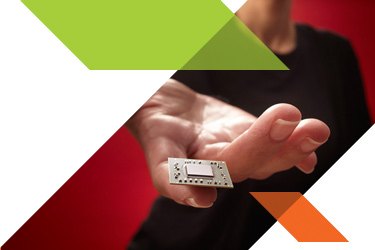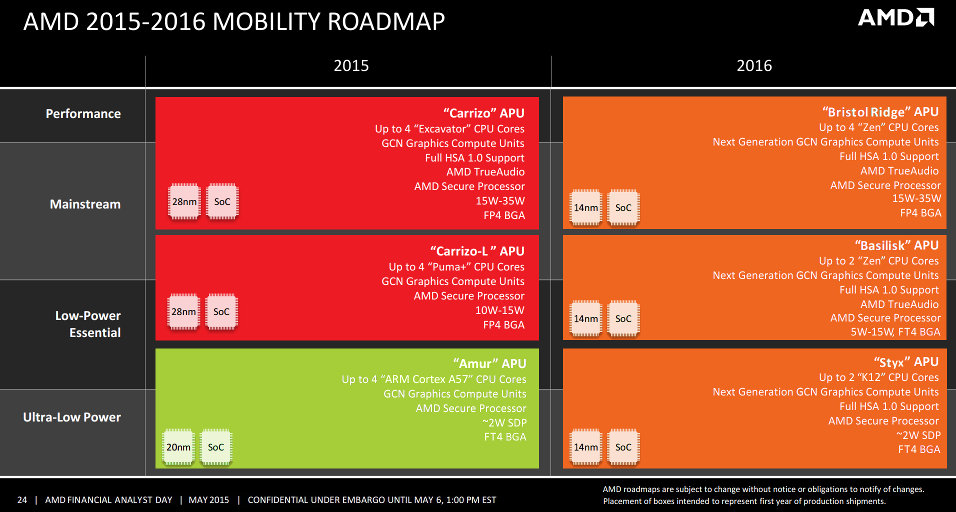Advanced Micro Devices first revealed plans to develop special low-power/low-cost x86 micro-architectures in mid-2007 in a bid to compete for ultra-portable and inexpensive devices. The micro-architectures got their names – Bobcat, Jaguar and Puma – from cats to emphasize their agility and efficiency. Eight years later AMD abandons development of future low-power x86 cores.
AMD has significantly reconsidered its plans concerning ultra-low-power accelerated processing units for mobile, hybrid and emerging applications. Starting this year, the company will no longer offer any new x86-based ultra-low-voltage system-on-chips, according to a leaked slide from the company’s roadmap. Moreover, AMD has cancelled its code-named “Nolan” APU that belonged to its “Skybridge” family of chips.
For many years AMD has been trying to address the market of media tablets, set-top-boxes and other low-power applications with down-clocked microprocessors powered by the company’s low-power/low-cost x86 cores. While AMD’s chips were not too power hungry, they lacked software support (mobile and embedded software is optimized for ARM hardware), were still hotter than many competing offerings and lacked tangible advantages over rivals. As a result, the number of AMD’s tablet design was very limited.
AMD’s final attempt to address the market of ultra-low-power applications with x86-based offerings was announced last year, when the company rolled-out its project “Skybridge” initiative. Under the plan, AMD intended to develop two pin-to-pin compatible accelerated processing units – “Amur” and “Nolan” – with identical building blocks and functionality, but with different cores: x86 Puma+ (Nolan) or ARM Cortex-A57 (Amur). Based on AMD’s mobility roadmap for 2015 – 2016, which was published on Wednesday, AMD no longer plans to offer “Nolan” APU.
Later this year AMD intends to roll-out its “Amur” system-on-chip for ultra-low-power applications with up to four ARM Cortex-A57 cores, a Radeon graphics processing unit with GCN architecture as well as security capabilities. The “Amur” APU will lack heterogeneous system architecture (HSA) capabilities and may not become a significant product for AMD at all. The SoC will be made using 20nm process technology at TSMC and it looks like this will be AMD’s only chip (which it will sell under its own name) to be made using this fabrication process.
It should be noted that the cancellation of “Nolan” is not the end of project “Skybridge” in general. AMD’s upcoming “Basilisk” and “Styx” accelerated processing units are pin-to-pin compatible and have a lot of similar building blocks (e.g., similar graphics processing unit, heterogeneous system architecture and so on). Generally speaking, “Skybridge” concept will be used by AMD for its future SoCs.
By contrast, it does not look like AMD has plans to develop any new low-power/low-cost x86 architectures in the future. In 2016 the company will not offer any chips based on its “cats” micro-architectures, but will stick to offerings powered by “Zen” and “K12” cores. Keeping in mind that AMD needs to optimize its research and development costs, abandoning development of low-power/low-cost x86 architectures is completely justified.
AMD did not comment on the news-story.
Discuss on our Facebook page, HERE.
KitGuru Says: In fact, the significance of low-power/low-cost x86 cores nowadays is much smaller than their importance several years ago. Firstly, modern high-performance x86 cores are developed with low power consumption in mind. Secondly, modern x86 cores are very compact and account for only a small fraction of modern SoC die areas (it is rumoured that AMD Zen core size is less than 10mm², which is larger than core sizes of “Jaguar” or “Puma”, but which is dramatically smaller compared to previous-gen x86 cores). As a result, it is possible to design a tiny system-on-chip with high-performance x86 cores. Intel’s Core M processor is a great example of such SoC. Alternatively, it is possible to use low-power ARMv8-compatible cores.
 KitGuru KitGuru.net – Tech News | Hardware News | Hardware Reviews | IOS | Mobile | Gaming | Graphics Cards
KitGuru KitGuru.net – Tech News | Hardware News | Hardware Reviews | IOS | Mobile | Gaming | Graphics Cards





Different cores: x86 Puma+ (Amur) or ARM Cortex-A57 (Nolan). Based on AMD’s mobility roadmap for 2015 – 2016, which was published on Wednesday, AMD no longer plans to offer “Nolan” APU.
Later this year AMD intends to roll-out its “Amur” system-on-chip for ultra-low-power applications with up to four ARM Cortex-A57 cores.
Am I the only one thinking that ARM Cortex-A57 (Nolan) and x86 Puma+ (Amur) are typos?
beat me to it….”x86 Puma+ (Nolan) or ARM Cortex-A57 (Amur)”
I also noticed on the roadmap, that the Carrizo-L is the Puma+, and the Amur is the Cortex A57. Based on a search I did for Nolan, and the fact that Carrizo-L didn’t seem to exist previously, it is entirely possible that Nolan got renamed to Carrizo-L.
Nolan is GF20LPM, Whether it’s cancelled or not or if the leak is a fake, I am not sure. Design world is small, word gets around so I can assure you Nolan is GF20LPM.